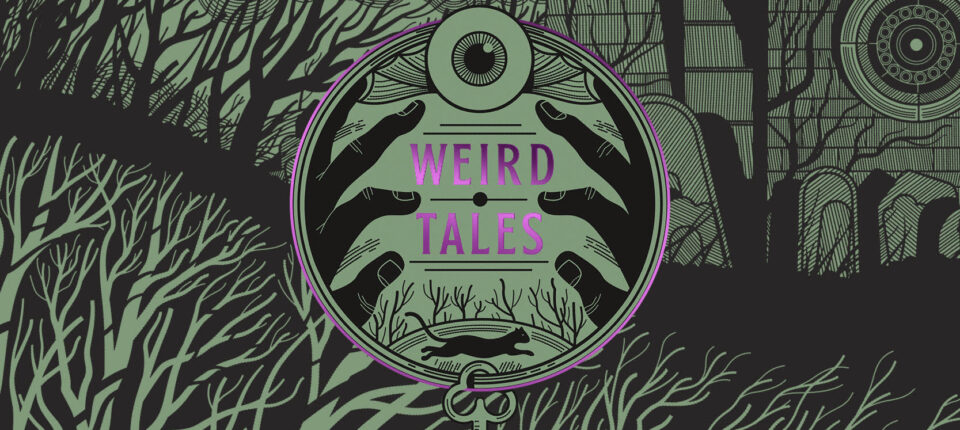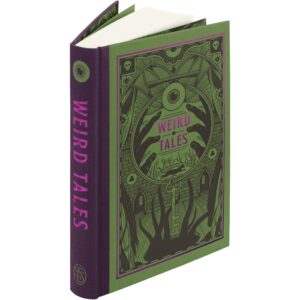The Washington Post’s Pulitzer Prize-winning book critic Michael Dirda has chosen 12 of the best weird tales ever written for a new collection from The Folio Society titled, appropriately enough, Weird Tales. Our editor Olivia Rutigliano spoke to Dirda. a longtime aficionado of the “weird,” about his selections.
This interview has been edited for concision and clarity.
OR: You’ve done such wonderful research in the history of “weird tales”—the magazine of that name, and MAM/pulp publications and sci-fi and horror stories, in general.
MD: Let me start by underscoring that The Folio Society collection Weird Tales only draws one story from the self-appointed “unique magazine” of that name. That would be Lovecraft’s “The Call of Cthulhu.” Instead, the book is, more broadly, both a sampler and survey of weird short fiction from the mid 19th-century to the beginning of the 21st. Let me point out, too, that I’ve been an editor and reviewer, written introductions to all sorts of books, and published a half dozen collections of essays, as well as a memoir, but Weird Tales was my first foray into compiling an anthology. For this opportunity, I am grateful to Tom Walker, editor of the Folio Society, who invited me to assemble a companion volume to the society’s excellent anthologies of ghost stories and horror stories. It was also my good luck to have his colleague, Mandy Kirby, for advice and guidance through the whole production process. In truth, Mandy did much of the nuts-and-bolts work, assisted by the accomplished Folio staff and artist Henry Campbell, to make this handsome book a reality. I can’t thank them enough.
OR: Harry Campbell did the gorgeous illustrations in this edition– how was it to see his renderings compared to the visuals that have been in your mind’s eye when you’ve read the tales?
MD: Whether it was a decision by Campbell himself or the Folio Society, the use of the colors black and green throughout gives his illustrations a deliciously unnatural air that is slightly head-spinning. The particular shade of the latter color always reminds me of Captain Hook’s line, in the musical version of “Peter Pan,” about baking a cake with poison until it turns a tempting green. Campbell’s art is, moreover, varied, ranging from tentacled horrors to the witchy beauty of Medea da Carpi in “Amour Dure.” Appropriately, the touches of purple on the book’s cover add to the jarring weirdness of Weird Tales.
OR: I’d love to hear more about the selection process of stories for this edition, namely about the toil of whittling down this canon. Were there any stories that you really wanted to include but didn’t get to?
MD: Given the huge number of stories dealing with the supernatural, spectral, and occult, I began by setting some limits for myself. With some regret, I decided to restrict the book to works written in English, which meant leaving out such favorites as E.T.A. Hoffmann’s “The Sandman” and Maupassant’s “The Horla.” From here, I adopted the following rules: 1) Because the Folio Society publishes books for the general reader, I decided to focus on the genre’s short-fiction classics. I wanted Weird Tales to serve as an introduction to some wonderful reading for people, young and old, who were relatively unfamiliar with the genre. 2) The Folio Society recently issued excellent anthologies devoted to ghost stories (introduced by Kathryn Hughes) and horror stories (introduced by Ramsey Campbell) and there seemed no point in duplicating anything from those volumes. Otherwise, Weird Tales would have included Charlotte Perkins Gilman’s “The Yellow Wallpaper” and Arthur Machen’s tour-de-force “The White People.” Machen, however, is represented by his only slightly more conventional but comparably unsettling, “Novel of the Black Seal.” 3) Besides choosing classics, I wanted the book to reflect the genre’s variousness. Some stories are viscerally shocking, others simply emphasize the uncanny, a couple mix eros with horror, one or two are deeply enigmatic, and two–Karl Edward Wagner’s “Sticks” and Mark Samuel’s “The White Hands”–even carry a post-modernist vibe, deliberately playing variations on familiar tropes. 4) While all the stories in Weird Tales are personal favorites, I did consult with knowledgeable friends for suggestions. Those friends included Stefan Dziemianowicz, who has edited or co-edited numerous anthologies of genre fiction; Robert Knowlton, whose familiarity with horror and dark fantasy is unrivalled; and members of an online discussion group called Fictionmags, a hive-mind possessing immense knowledge of popular fiction. In short, I performed due diligence to be sure I hadn’t overlooked an essential story.
5) At this point, I made several longlists. Here’s one of them:
Sheridan Le Fanu, “Schalken the Painter” (1839)
Rhoda Broughton, “The Man With the Nose” (1872)
Margaret Oliphant, “The Library Window” (1879)
Vernon Lee (aka Violet Paget), “Amour Dure” (1887)
Madeline Yale Wynne, “The Little Room” (1895)
H.G. Wells, “The Door in the Wall” (1906)
Algernon Blackwood, “The Willows” (1907)
M.R. James, “Casting the Runes” (1911)
Oliver Onions, “The Beckoning Fair One” (1911)
William Hope Hodgson, “The Derelict” (1912)
E.F. Benson, “The Room in the Tower” (1912)
Max Beerbohm, “Enoch Soames” (1916)
Lord Dunsany, “The Three Sailors’ Gambit” (1916)
Marjorie Bowen, “The Sign-Painter and the Crystal Fishes” (1917) Walter de la Mare, “Seaton’s Aunt” (1921)
H. F. Arnold, “The Night Wire” (1926)
Cynthia Asquith, “The Corner Shop” (1926)
H. P. Lovecraft, “The Call of Cthulhu” (1928)
Ann Bridge, “The Buick Saloon” (1936)
E.B. White, “The Door” (1939)
Gerald Kersh, “Men without Bones” (1955)
Jack Finney, “Of Missing Persons” (1956)
J. G. Ballard, “The Voices of Time” (1960)
Karl Edward Wagner, “Sticks” (1974)
Robert Aickman, “The Hospice” (1975)
Fred Chappell, “The Adder” (1989)
Joyce Carol Oates, “The Ruins of Contracoeur” (1999)
Mark Samuels, “The White Hands” (2006)
6) Space is the final frontier. Many of the greatest weird tales are quite long, but I needed to keep this anthology to a reasonable number of pages, so several major works–such as Oliver Onions’s “The Beckoning Fair One,” Marjorie Bowen’s “Julia Roseingrave” and Joyce Carol Oates’s “The Ruins of Contraceur”–were set aside simply because of their length. Perhaps some day there will be a Weird Tales II. Other stories, such as Max Beerbohm’s “Enoch Soames” and Lord Dunsany’s “The Three Sailors’ Gambit” didn’t carry enough weirdness in their overall atmospheres, being essentially comic. In the end, I did include one living author–Mark Samuels–but sad to say he died unexpectedly while Weird Tales was in production. Let me take this space to urge readers to check out his eerie and wonderful fiction. A good sampler is The Age of Decayed Futurity: The Best of Mark Samuels (Hippocampus Press). For that matter, I hope readers intrigued by, say, Vernon Lee’s “Amour Dure” Mary E. Wilkins Freeman’s “The Hall Bedroom,” or Robert Aickman’s “The Hospice,” will want to seek out their other stories.
OR: We are fortunate that characters like Cthulhu have finally found their way to mainstream culture, after spending decades being known by only a small population of readers. What’s another character or story or author from this group that you wish more people knew about or widely read.
MD: Well, there aren’t too many characters like Lovecraft’s Cthulhu–fortunately for us. As his worshippers say, “Ph’nglui mglw’nafh Cthulhu R’lyeh wgah’nagl fhtagn”, i.e., “In his house at R’lyeh, dead Cthulhu waits dreaming.” M.R. James’s “Casting the Runes” did loosely inspire Jacques Tourneur’s cult film “Night of the Demon” and Blackwood’s “The Willows” was Lovecraft’s own favorite supernatural tale. But let me stress again that my hope is that readers will enjoy all these stories while also discovering a few authors whose work they will want to explore further. If there’s one thing reading weird tales teaches us, the past is never really past. Like Cthulhu, it is only waiting for the right time to return.
__________________________________
The Folio Society edition of Weird Tales, selected and introduced by Michael Dirda and illustrated by Harry Campbell, is exclusively available from foliosociety.com


















